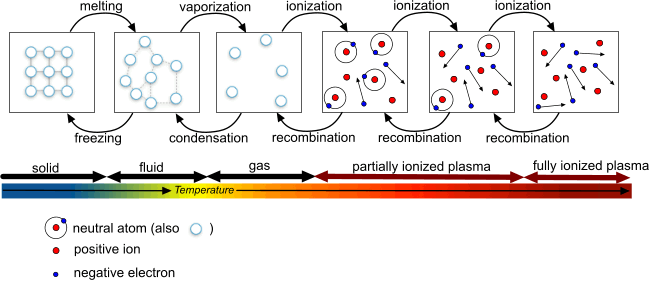Plasma
Plasma is a state of matter similar to a gas that is composed partially or completely of charged particles such as ions and electrons which are not bound to each other.
What Is Plasma?
Each type of atom has an ionization energy—which is the amount of energy that is required to remove one mole of electrons from one mole of gaseous atoms. When an atom encounters enough energy to overcome its ionization energy, the atom decomposes into an electron and a positively charged ion.

These unbound charged particles are the components of plasma. A gas can display plasma-like properties when only a small proportion of atoms in a sample of the gas are ionized. Electromagnetic fields affect the unbound charged particles—which move collectively as plasma.
There are a large variety of different types of plasma which you can characterize by differences in their properties, such as gas density and electron density. For example, plasma exists in the following places:

Modeling Plasmas
Different types of plasmas are modeled differently depending on their properties and composition. The following modeling assumptions are made:- When plasmas are in Local Chemical Equilibrium (LCE), the parent gas composition, temperature, and pressure are used to determine the composition of the plasma—which is in quasi-steady state. Since the gas composition, temperature, and pressure are known, you can tabulate the plasma material properties in advance.
- When plasmas are in Non-Local Chemical Equilibrium (non-LCE), the composition of the plasma is fluctuating which means that you must solve the chemical reaction equations.
- When plasmas are in Local Thermal Equilibrium (LTE), the temperature of the electrons is equal to the temperature of the parent gas.
- When plasmas are in Non-Local Thermal Equilibrium (non-LTE), the temperature of the electrons is higher than the parent gas temperature. However, due to the small size of the electrons, the overall temperature of the gas is taken as the parent gas temperature. The static temperature defines the minimum electron temperature during iterative processes.
Currently in Simcenter STAR-CCM+, you can model the following types of industrial plasma:
- Cold, non-thermal plasma
This type of plasma consists of weakly ionized particles which are generated by heating electrons through inductive or capacitive coupling. Since the plasma density is small compared to the gas density, the dilute plasma species have a negligible influence on the gas properties. For this reason, non-LTE plasmas are known as cold plasmas, since the overall temperature of the gas is taken as the parent gas temperature. However, the high energy electrons can still trigger chemical reactions by colliding with background gas particles and causing those particles to ionize. Cold, non-thermal plasmas are used in applications such as plasma-CVD, plasma actuators, coronas, and flow discharges.
In Simcenter STAR-CCM+, you can use the Charge Accumulation Model to account for charge accumulation when calculating the charged species dynamics next to interfaces between dielectric surfaces and the gas/plasma.
- Arc plasma
This type of plasma consists of highly ionized particles which are generated when a large current of high voltage creates an electric arc between two electrodes. As this electric arc passes through a gas, the gas particles are heated strongly and become ionized. Since the particles are ionized strongly, chemical equilibrium is assumed, and due to the frequent collisions of particles, the electrons remain in thermal equilibrium with the gas temperature. However, it is possible that the particles are in non-thermal equilibrium near the electrodes or walls. In Simcenter STAR-CCM+, you can use the Ohmic Heating model to model the large temperatures from Joule heating.
Arc plasmas are used in applications such as plasma torches, circuit breakers, welding torches, and thermal spraying.
See: Modeling Plasma Arcs.
- Reacting flow plasma
For this type of plasma, the temperature is low enough in parts or the entire system to take chemical reactions such as ionization and excitation into account. Calculating plasma chemistry allows you to simulate applications such as Plasma Enhanced CVD and Physical Vapor Deposition (e.g. sputtering) in cases where the plasma chemistry plays an important role.
For plasma simulations in which charge neutrality can be assumed, Simcenter STAR-CCM+ also provides the Ambipolar Diffusion model.
| Note | If the gas density (Knudsen Number) becomes too low, the continuum assumption—which is required for gas flow modeling using Navier-Stokes equations, becomes invalid. |